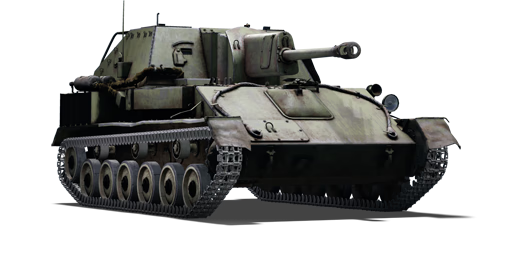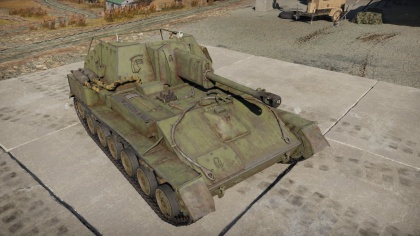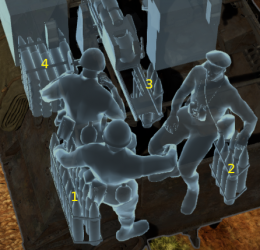SU-76M
Contents
Description
The SU-76M is a rank I Soviet tank destroyer
with a battle rating of 2.0 (AB/RB/SB). It was introduced during the Closed Beta Test for Ground Forces before Update 1.41.
The SU-76 is a fairly versatile Rank 2 assault gun, equipped with a very good gun for its BR of 2.3.
Overall, the Su-76M is to be played defensively, with the ability to carry out some sneaky, cautious flanks if given a decent opportunity, but it should never get into prolonged fighting up close. A two-versus-one situation is very unfavourable for this vehicle.
The further research will then lead you to its successor – a fully enclosed SU-122, carrying more armour, but mainly the massive 122 mm howitzer.
General info
Survivability and armour
Armour type:
- Rolled homogeneous armour
| Armour | Front | Sides | Rear | Roof |
|---|---|---|---|---|
| Hull | 25 mm (60°) Front glacis 30 mm (30°) Lower glacis 25 mm (35-89°) Driver's hatch |
15 mm | 15 mm (1°) Top 15 mm (32°) Lower |
7 mm |
| Superstructure | 25 mm (27°) | 10 mm (21-24°) Left 10 mm (18-19°) Right |
15 mm (1°) | N/A |
Notes:
- Suspension wheels are 10 mm thick while tracks are 15 mm thick.
- Belly armour is 7 mm thick.
- The rear superstructure does not cover the entire crew compartment.
- A 25 mm plate of armour separates the driver's and engine compartment to the rear fighting compartment.
Mobility
| Mobility characteristic | ||
|---|---|---|
| Weight (tons) | Add-on Armor weight (tons) |
Max speed (km/h) |
| 10.5 | N/A | 33 (AB) |
| 30 (RB/SB) | ||
| Engine power (horsepower) | ||
| Mode | Stock | Upgraded |
| Arcade | 199 | 245 |
| Realistic/Simulator | 124 | 140 |
| Power-to-weight ratio (hp/ton) | ||
| Mode | Stock | Upgraded |
| Arcade | 18.95 | 23.33 |
| Realistic/Simulator | 11.81 | 13.33 |
Armaments
| 76 mm ZiS-3 | |||||
|---|---|---|---|---|---|
| Capacity | Vertical guidance |
Horizontal guidance |
Stabilizer | ||
| 60 | -3°/+25° | ±15° | N/A | ||
| Turret rotation speed (°/s) | |||||
| Mode | Stock | Upgraded | Prior + Full crew | Prior + Expert qualif. | Prior + Ace qualif. |
| Arcade | 4.20 | 5.80 | _.__ | __._ | __._ |
| Realistic | 4.20 | 4.90 | _.__ | __._ | __._ |
| Reloading rate (seconds) | |||||
| Stock | Prior + Full crew | Prior + Expert qualif. | Prior + Ace qualif. | ||
| 9.0 | __.__ | __.__ | __.__ | ||
Ammunition
| Penetration statistics | |||||||
|---|---|---|---|---|---|---|---|
| Ammunition | Type of warhead |
Penetration in mm @ 90° | |||||
| 10m | 100m | 500m | 1000m | 1500m | 2000m | ||
| BR-350A | APHEBC | 86 | 85 | 76 | 67 | 59 | 52 |
| BR-350SP | APBC | 102 | 100 | 91 | 81 | 72 | 64 |
| BR-350P | APCR | 135 | 130 | 92 | 60 | 39 | 26 |
| BP-350A | HEAT | 80 | 80 | 80 | 80 | 80 | 80 |
| BR-350B | APHEBC | 94 | 92 | 83 | 73 | 65 | 57 |
| OF-350M | HE | 10 | 10 | 10 | 10 | 10 | 10 |
| Sh-354T | Shrapnel | 37 | 35 | 29 | 25 | 20 | 17 |
| Shell details | ||||||||||
|---|---|---|---|---|---|---|---|---|---|---|
| Ammunition | Type of warhead |
Velocity in m/s |
Projectile Mass in kg |
Fuse delay
in m: |
Fuse sensitivity
in mm: |
Explosive Mass in g (TNT equivalent): |
Normalization At 30° from horizontal: |
Ricochet: | ||
| 0% | 50% | 100% | ||||||||
| BR-350A | APHEBC | 665 | 6.3 | 0.15 | 10.0 | 150 | +4° | 48° | 63° | 71° |
| BR-350SP | APBC | 680 | 6.8 | N/A | N/A | N/A | +4° | 48° | 63° | 71° |
| BR-350P | APCR | 950 | 3.0 | N/A | N/A | N/A | +1.5° | 66° | 70° | 72° |
| BP-350A | HEAT | 355 | 5.3 | 0.1 | 0.1 | 1,060 | +0° | 62° | 69° | 73° |
| BR-350B | APHEBC | 680 | 6.3 | 0.9 | 15.0 | 108.8 | +1.5° | 48° | 63° | 71° |
| OF-350M | HE | 680 | 6.2 | 0.05 | 0.1 | 621 | +0° | 79° | 80° | 81° |
| Sh-354T | Shrapnel | 680 | 6.2 | 0.5 | 8.0 | 85 | +0° | 62° | 69° | 73° |
| Smoke characteristic | ||||||
|---|---|---|---|---|---|---|
| Ammunition | Velocity in m/s |
Projectile Mass in kg |
Screen radius in m |
Screen time in s |
Screen hold time in s: |
Explosive Mass in g (TNT equivalent): |
| D-350A | 680 | 6.5 | 13 | 5 | 20 | 50 |
Ammo racks
| Full ammo |
1st rack empty |
2nd rack empty |
3rd rack empty |
4th rack empty |
Visual discrepancy |
|---|---|---|---|---|---|
| 60 | 46 (+14) | 31 (+29) | 16 (+44) | 1 (+59) | yes |
Usage in the battles
As is common with Tank Destroyers, the SU-76M needs to be handled with care. Not only does it not have a rotating turret, it has an open top and practically no protection from behind. Therefore, when an engagement's complexity evolves and the Su-76 is surrounded, there is little that can be done to survive. One well placed hit to its rear will knock out a good part of the exposed crew, even machine guns can do the job of eliminating both loader and gunner.
Therefore, it is crucial to remain at a distance from the enemy, perhaps even seek the cover of trees for protection against low-level attack aircraft, and to only ever give the front side to an enemy. The fact that this vehicle does not have a turret not only means that it is not effective when fighting more mobile enemies attempting to flank, it also means that placing your armour at an angle is not a viable strategy to increase relative armour thickness and stay more protected, since the gun's limits for horizontal traverse mean that any significant angle of the hull towards an enemy will make it harder to keep the enemy in sight. What can be done is to fire a shot and, immediately after, angle the hull whilst reloading, to then return to facing the enemy to fire another shot. However, hiding whilst reloading is the most sensible choice.
Unfortunately, the SU-76 has fairly poor mobility, handling, and a vastly different gun when compared to its smaller and more mobile cousin, the Zis-30. You could compare the Zis-30s gun to a nail. Its gun will pierce through anything at its rank, making most tanks armour seem like paper, but sometime its internal damage will be minimal and confined to the area that it penetrates. The gun on the SU-76 is more like a hammer. The sheer force of the shells will cause huge amounts of trauma to a target upon penetration. The SU-76 is also better armoured than the Zis-30 and provides much more protection to the gunner crew, especially from smaller calibre rounds (Unless fired from the rear). Given its poor gun depression and velocity, the SU-76 should be used as a mobile brawler and ambusher. It is well suited to performing ambushes in urban areas. The high HE filler of the 76mm shell makes it capable of OHK'ing nearly all enemy armour at its 2.3 BR. A minor issue with the SU-76 is that it has no defensive machine gun, meaning that responding quickly to SPAA is difficult.
The gun in itself is what makes the SU-76M a good vehicle, all its other characteristics are less than impressive. The variety of ammunition is a definite pro for this SPG, its APCR and HEAT shells being effective even at higher ranks, giving this humble tank destroyer the ability to down high-tier tanks like the Tiger H1. Recently, the much more effective late-war BR-350B ammunition has been added to the SU-76M's ammunition options. It features noticeably more penetration and a better fuze in exchange for somewhat less explosive mass. Despite this, you will often destroy most enemies in one shot when you penetrate. Once unlocked, the SU-76 is quite capable of dealing with any tank it is likely to see from the front, though you may have to swap ammunition often to deal with different targets.
Pros and cons
Pros:
- Good gun
- Good selection of ammunition
- Decent HE filler in the AP shell
- Mobile
- Low profile
- Adequate penetration with BR-350B shell
- Access to APCR shell
Cons:
- Open topped
- Weak armour, can be vulnerable to SPAAs
- Gun performs poorly at long ranges
- Vulnerable to strafing fighters
- Easy prey when up-tiered; more capable vehicles, such as the Pz.IV F2, StuG III F, and Pz.III M are within the battle rating reach
- Vulnerable to HE shells
History
Development
During the interwar years, the development of self-propelled artillery was practically nonexistent in the Soviet Union. Those few projects, based on the chassis of T-26 light tank, such as SU-1, AT-1 or SU-26, were eventually cancelled, and the Red Army entered the Second World War entirely without a dedicated self-propelled gun.
The situation changed after the German invasion in 1941, and vehicles such as the SU-152 or SU-122, based on the KV-1 and T-34 tanks respectively, were developed. In November 1942, the State Defense Committee then ordered the production of a light self-propelled gun, built on the chassis of a light tank and armed with a 76.2 mm gun. The T-70 light tank chassis was chosen, as the other light tanks, the T-50 and T-60, was already out of production. The chassis had to be modified for this role, so it was lengthened and had one additional pair of road wheels added to the design. The armament, the 76.2 mm divisional M1942 gun (also designated ZiS-3), was mounted in a fully enclosed casemate. The gun was positioned at the rear, with the transmission being mounted frontally. The vehicle was designated SU-76 (Samokhodnaya Ustanovka, “Self-Propelled Gun“), and the production was issued to the No.38 Factory in Kirov and started in December 1942. However, after only a couple of hundred vehicles were produced, the production was halted due to serious mechanical problems and other issues. The power train consisted of two GAZ-202 automobile engines, with each powering one track. However, there was no synchronization gear, so the driver has to control both engines simultaneously, which was an extremely difficult task. This arrangement also caused strong vibrations, which were the cause of frequent engine and transmission failures. The second biggest issue was the enclosed crew compartment, as it was very cramped and offered only a little space for crew members to work properly. The vehicle thus had to be modified, firstly the roof of the crew compartment was removed, improving the access to the gun. The power train was also changed, receiving the more powerful GAZ-203 engines, each producing 85 horsepower, which was now mounted in tandem on the right side of the vehicle, propelling a single drive-shaft. The modified vehicle was designated SU-76M, and its production was resumed in early 1943. More than 14,000 SU-76M’s were produced between 1942-1945, making it the second most produced armoured vehicle in the Soviet Union after the T-34 tank.
Combat usage
In its intended role, the SU-76M replaced earlier infantry support tanks and was very welcome to Soviet infantry units as it provided them with a light and mobile universal support weapon. The vehicle was meant to be part of three battlefield roles - a light assault gun, a mobile tank destroyer, or a mobile artillery gun as the weapon could be fired indirectly at a range of 17 km. The vehicle was fairly lightweight and produced low ground pressure, enabling it to pass through terrain unsuitable for heavier vehicles. Its gun could utilize a multitude of ammunition types, aside from standard high explosive ammunition, it could use fragmentation, shrapnel, incendiary and smoke rounds. As a tank destroyer, the gun was sufficient against German light and medium tanks such as Panzer III or Panzer IV. The introduction of the APCR and HEAT rounds then enabled SU-76M units to engage even heavier Panther and Tiger tanks with some success, though crew manuals instructed the gunner to try to hit the tracks or gun barrels before these rounds were made.
The vehicle also proved itself effective in an urban environment, where it was used as an assault gun for direct fire against enemy strong points and fortifications. The open-topped casemate made the crew vulnerable to snipers and hand grenades, but it also made the communication between vehicle commander and any accompanying infantry easier. Plus, it was found that the open compartment actually helps against the German infantry anti-tank weapon Panzerfaust, where a closed space would ensure the death of the crew members from the blast concussion amplified in the closed space. The SU-76M's low ground pressure from its weight made it one of the only Soviet vehicles able to operate in swampy terrain, which was extremely helpful during the Belarus Campaign in 1944, allowing the vehicle to attack through swamps in raids. This allowed the Soviets to bypass German defensive areas on more suitable terrain with support of an assault gun accompanying the light infantry. One famous SU-76M user was Rem Nikolaevich Ulanov, who was famous World War II veteran and his crew called their SU-76 the "Columbina".
After the end of World War II, the SU-76M was phased out of production, but many of them were exported to other countries, such as China, Cuba, North Korea, North Vietnam or Czechoslovakia, where they would be used in conflicts such as the Korean and Vietnam War against the US and their allies.
In-game description
"The SU-76M was created based on the T-70M light tank as a mobile infantry escort. In the front of the vehicle, the driver was seated on the left and the engine compartment was on the right. The fighting compartment was in the rear of the vehicle, in a cabin open at the top and partially open at the rear. The vehicle's crew consisted of 4 people. The vehicle's commander and loader sat on the right of the armoured cabin, and the gunner sat to the left of the cannon.
The SPG was armed with a 76.2 mm ZiS-3 cannon. Placing the cannon in an armoured cabin simplified the production of these SPGs in comparison to manufacturing tanks, and allowed for them to be produced in a higher overall quantity. In 1944, when armoured vehicle production in the Soviet Union reached its height, around 25% of the overall number of full-track combat vehicles manufactured were SU-76Ms.
The No. 38, No. 40 and GAZ factories mass-produced these vehicles. By 1945, these factories had produced 13,932 SU-76Ms in total. Consequently, the SU-76M became the most prolific Soviet SPG in World War II.
Vehicles of this type were widely used in combat operations both as infantry support vehicles and as tank destroyers against enemy light tanks, medium tanks and SPGs. With different types of ammunition at hand, they were able to overwhelm infantry, artillery and armoured targets alike. A subcalibre round from the vehicle could penetrate 100 mm armour from a distance of 500 metres.
These SPGs gained an excellent reputation in battle. As a vehicle of its class, the SU-76M was practically equal in all regards to its foreign counterparts. After the war, the vehicles served in the Soviet Army until the beginning of the 50s, and in the DPRK army throughout the 50s."
Survivors
Due to the large quantity produced and usage after World War II, many are found in intact conditions today in various locations around the world. Some could even be found as war monuments for the Soviet and German memorials.
Media
Skins and camouflages for the SU-76M from live.warthunder.com.
Read also
Sources
Paste links to sources and external resources, such as:
- topic on the official game forum;
- other literature.
| USSR tank destroyers | |
|---|---|
| SU-76M | SU-76M · SU-76M (5th Gv.Kav.Corps) · SU-85A |
| SU-57B | SU-57B · SU-76D |
| T-34 Derivatives | SU-122 · SU-85 · SU-85M · SU-100 · SU-122P |
| Heavy Tank Derivatives | SU-100Y · ISU-122 · ISU-122S · SU-152 · ISU-152 · Object 268 |
| SU-100P and Derivatives | SU-100P · Object 120 |
| Wheeled | YaG-10 (29-K) |
| Airborne | ASU-57 · ASU-85 |
| Rocket | BM-8-24 · BM-13N · BM-31-12 |
| ATGM | IT-1 · Shturm-S · Object 775 · Khrizantema-S |
| Artillery | 2S1 · 2S3M |
| Other | SU-5-1 · ZiS-30 · SU-122-54 |
| USA | SU-57 |






